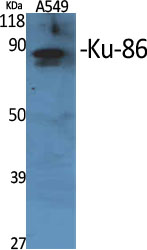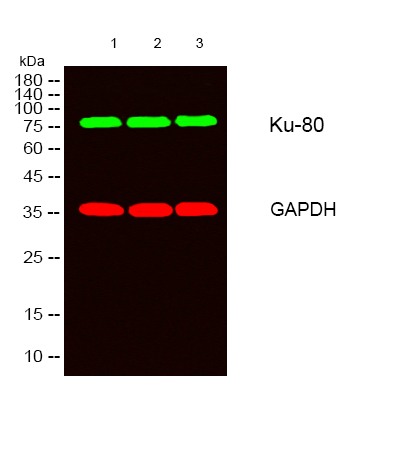LIMK1 (Phospho Ser310) rabbit pAb
- Catalog No.:YP1777
- Applications:WB
- Reactivity:Human;Mouse;Rat
- Target:
- LIMK-1
- Fields:
- >>Axon guidance;>>Fc gamma R-mediated phagocytosis;>>Regulation of actin cytoskeleton;>>Yersinia infection;>>Human immunodeficiency virus 1 infection
- Gene Name:
- LIMK1 LIMK
- Protein Name:
- LIMK1 (Phospho-Ser310)
- Human Gene Id:
- 3984
- Human Swiss Prot No:
- P53667
- Mouse Gene Id:
- 16885
- Mouse Swiss Prot No:
- P53668
- Rat Swiss Prot No:
- P53669
- Immunogen:
- Synthesized peptide derived from human LIMK1 (Phospho-Ser310)
- Specificity:
- This antibody detects endogenous levels of LIMK1 (Phospho-Ser310) at Human, Mouse,Rat
- Formulation:
- Liquid in PBS containing 50% glycerol, 0.5% BSA and 0.02% sodium azide.
- Source:
- Polyclonal, Rabbit,IgG
- Dilution:
- WB 1:500-2000
- Purification:
- The antibody was affinity-purified from rabbit serum by affinity-chromatography using specific immunogen.
- Concentration:
- 1 mg/ml
- Storage Stability:
- -15°C to -25°C/1 year(Do not lower than -25°C)
- Other Name:
- LIM domain kinase 1 (LIMK-1) (EC 2.7.11.1)
- Observed Band(KD):
- 80kD
- Background:
- There are approximately 40 known eukaryotic LIM proteins, so named for the LIM domains they contain. LIM domains are highly conserved cysteine-rich structures containing 2 zinc fingers. Although zinc fingers usually function by binding to DNA or RNA, the LIM motif probably mediates protein-protein interactions. LIM kinase-1 and LIM kinase-2 belong to a small subfamily with a unique combination of 2 N-terminal LIM motifs and a C-terminal protein kinase domain. LIMK1 is a serine/threonine kinase that regulates actin polymerization via phosphorylation and inactivation of the actin binding factor cofilin. This protein is ubiquitously expressed during development and plays a role in many cellular processes associated with cytoskeletal structure. This protein also stimulates axon growth and may play a role in brain development. LIMK1 hemizygosity is implicated in the impaired visuospatial constructive cog
- Function:
- catalytic activity:ATP + a protein = ADP + a phosphoprotein.,disease:Haploinsufficiency of LIMK1 may be the cause of certain cardiovascular and musculo-skeletal abnormalities observed in Williams-Beuren syndrome (WBS), a rare developmental disorder. It is a contiguous gene deletion syndrome involving genes from chromosome band 7q11.23.,function:Protein kinase which regulates actin filament dynamics. Phosphorylates and inactivates the actin binding/depolymerizing factor cofilin, thereby stabilizing the actin cytoskeleton. Isoform 3 has a dominant negative effect on actin cytoskeletal changes. May be involved in brain development.,PTM:Autophosphorylated.,PTM:Phosphorylated on serine and/or threonine residues by ROCK1. May be dephosphorylated and inactivated by SSH1.,similarity:Belongs to the protein kinase superfamily. TKL Ser/Thr protein kinase family.,similarity:Contains 1 PDZ (DHR) doma
- Subcellular Location:
- Cytoplasm . Nucleus . Cytoplasm, cytoskeleton . Cell projection, lamellipodium . Predominantly found in the cytoplasm. Localizes in the lamellipodium in a CDC42BPA, CDC42BPB and FAM89B/LRAP25-dependent manner. .
- Expression:
- Highest expression in both adult and fetal nervous system. Detected ubiquitously throughout the different regions of adult brain, with highest levels in the cerebral cortex. Expressed to a lesser extent in heart and skeletal muscle.
- June 19-2018
- WESTERN IMMUNOBLOTTING PROTOCOL
- June 19-2018
- IMMUNOHISTOCHEMISTRY-PARAFFIN PROTOCOL
- June 19-2018
- IMMUNOFLUORESCENCE PROTOCOL
- September 08-2020
- FLOW-CYTOMEYRT-PROTOCOL
- May 20-2022
- Cell-Based ELISA│解您多样本WB检测之困扰
- July 13-2018
- CELL-BASED-ELISA-PROTOCOL-FOR-ACETYL-PROTEIN
- July 13-2018
- CELL-BASED-ELISA-PROTOCOL-FOR-PHOSPHO-PROTEIN
- July 13-2018
- Antibody-FAQs
- Products Images

- Western Blot analysis of 293T using primary antibody at 1:1000 dilution 4°C, overnight. Secondary antibody(catalog#:RS23920) was diluted at 1:10000 25°C,1.5hours

